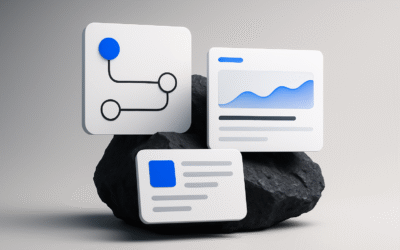I’ve rewritten my approach to sales more times than I care to admit. Some days, it almost feels like chasing shadows: tracking little wins, blaming missed revenue goals on a slow lead generation month, then doubling down on another trending methodology from someone else’s “proven” template. You can brute-force it for a while. Gut it out. But if you’re a business owner, or a sales manager sick of the revolving door of burned-out reps and clunky workflows, brute force won’t get you far. You’ll end up losing sleep, missing key metrics, and burning cash on the wrong “solutions.”
So, let’s cut the theory and talk about how to actually build a sales system that runs whether you’re awake or not. And let’s make it useful for small businesses (meaning you don’t have 40 reps, a 6-figure Salesforce bill, or a pipeline so fat with new leads that you can afford to waste half of them)
Sales Isn’t a Game of Luck. It’s a Game of Systems
I started treating sales like a slot machine the first year I took on my own clients. I’d hammer cold emails late at night, obsess over a few “hot” prospects, then try to reverse-engineer what worked when I finally closed a deal. All it did was create anxiety. I wanted “repeatable,” but my sales process was pure chaos.
The sellers who win consistently, are sellers who build simple, repeatable sales systems. They don’t guess or hope every time a new prospect appears. They know exactly how they’ll move a contact through their funnel, what automation handles followup, which KPIs to check, and where to focus their sales efforts to drive revenue.
Every business has gaps. For small businesses, those gaps usually show up in three places:
– No formal sales process. The salesperson (or, let’s be real, the founder) does deals in their own head. Next week, the process is different. Good luck training a rep.
– No reliable sales automation or CRM. Leads live in inboxes, sticky notes, or someone’s memory. You can’t optimize what you can’t see.
– No way to personalize without burning out. You know personal outreach works better, but who has time to write a custom email for every new lead?
If you recognize your own setup here, don’t sweat it. Just means you need to treat your business like a team sport, not a solo run.
Build a Sales System That Runs Without You
Let’s break this up, because “system” gets thrown around and no one means the same thing.
Here’s how I see a real, sustainable sales system:
- A documented, step-by-step sales process.
- CRM and sales automation doing the grunt work.
- Personalization without grinding your reps down.
- Smart analytics and reports, so you know what’s working.
- Sales enablement that actually supports the team—not just adds noise.
1. The Sales Process Isn’t a Suggestion. It’s Nonnegotiable
If your sales team (or, if you’re on your own, your sales mindset) doesn’t follow a consistent process, you don’t have a pipeline. You have random deals, a pile of expired contacts, and revenue forecasts that are pure fiction.
I tried skipping this for way too long. Every time I sat down to train a new salesperson, I realized I had nothing to give them except a pep talk and some frazzled notes.
A working sales process needs to hit these marks:
– Clear qualification: Are they a fit for your product or service? What does your best sales prospect look like? What’s a deal-breaker? Write it down.
– Defined sales cycle: Are you closing in days, weeks, or months? Map each step. Don’t improvise.
– Set followup windows: How long do you wait between touchpoints? What’s your sales team doing during “quiet” periods in the pipeline?
– Documented handoffs: If you have more than one seller or a business development rep feeding leads to a closer, outline the exact handoff process.
– Outcomes at each stage: What does “qualified” really mean in your funnel? What needs to be checked off before a deal moves from “Demo Scheduled” to “Proposal Sent”?
Make your process a template your sales reps can follow. New hires or teammates should be able to look at it and know exactly what to do. Competitors can mimic your pitch, but they don’t have your process.
2. Automate Everything That Isn’t Emotional
Here’s where most founders and small business sales managers get it wrong: they spend hours on admin tasks that AI and automation could crush in seconds.
I’ve now watched tons of small businesses overhaul their sales workflow with AI-powered tools. The best sales automation doesn’t turn your team into robots—it gives them back their time to actually be human where it matters.
The sweet spot is in the non-emotional work:
– Logging every call and email? Automate it. Every CRM worth using. Whether you’re on Salesforce, HubSpot, or even a fast, low-cost system like Pipedrive, you can log customer information, auto-populate contact information, and generate sales reports without a rep lifting a finger.
– Lead prioritization and scoring? Let AI highlight which salesperson should work which leads, and when.
– Email and followup sequences? Set them up once, personalize with fields that draw from CRM data, and let automation carry the weight. You can still step in when it’s time to close deals, but not every “Hey, just checking in” needs to be written by hand.
Don’t try to automate the relationship. Your sales team still brings the human touch (empathy, humor, timing) But everything else? Automate or delegate.
3. Personalize, But Don’t Go Crazy
Small businesses win when they sound human, not canned. Prospects ignore generic followup and “just checking in” emails. Yet if you turn every outreach into a bespoke masterpiece, you’ll either burn your sales rep out or kill your pipeline velocity.
Real personalization comes from using the right sales tools to let you integrate customer information where it matters. Your CRM should let you insert personal references, business names, or key pain points into each message without having to dig through scattered notes or LinkedIn profiles.
I started using AI-powered automation to prep short icebreakers in emails or remind me which product or service the prospect bought last year. Analytics tools then show which type of personalization (personal story, key metric, or competitor comparison) actually improves conversions. Most CRMs (even the budget ones) now include these features out of the box.
The trick is to make it feel intentional, but not energy-sapping. Use templates for structure, then top and tail with your human spin. The goal: sales automation does the heavy lifting, you step in for what matters.
4. Analytics Aren’t Just for the Big Guys
Every sales manager I’ve met at a small company tells me KPIs and analytics sound great but “aren’t really for our kind of business.” Truth is, the smaller you are, the more every metric matters.
If you’re not tracking sales pipeline movement, lead source, rep performance indicators, conversion rates at each stage, and followup timing, you’re guessing.
The old school way: chasing gut feelings, letting the same sales person own everything, waiting months to see if revenue improves.
The new way: your sales CRM spits out simple sales reports every Friday. You track a handful of key metrics:
– Number of new leads added
– Lead-to-meeting conversion rate
– Proposal-to-close ratio
– Average sales cycle length
– Followup time lapses
– Salesperson activity volume
Doesn’t matter which SaaS you pick (Salesforce, HubSpot, Copper, Pipedrive)all give you dashboards for sales leaders and business owners. Even ten minutes a week with these analytics changes everything. You start seeing patterns: which sales rep is stuck in the funnel, where pipeline drops off, which competitor’s customers respond to your outreach, and where your revenue goals need to be revisited.
5. Sales Enablement Isn’t Slides. It’s Clarity
I wasted countless hours trying to coach salespeople by sending them 50-slide decks or long-winded docs full of “strategy.” Most of it never helped. Sales enablement means giving your sales team (or yourself) the right sales training, resources, and cheat sheets to work smarter.
This could look like:
– Short product or service one-pagers for quick reference
– Call scripts (not to be read word for word, but to kill “uhh…” moments)
– Objection-handling templates
– Quick access to competitor comparisons
– Simple internal wikis with steps to update contact information, run pipeline reports, or request support
The point isn’t to crank out more noise. It’s to remove friction so any salesperson, at any stage of training, can focus on conversations that close deals—not searching through Slack threads at 7pm for last December’s pricing sheet.
Best Sales Strategies for Small Businesses (That Actually Work in 2025)
Some sales strategies feel out of reach for small businesses. But good news: plenty of the “big” methods make more sense for smaller teams, especially if you automate the right pieces and focus on the most direct levers.
Here’s what works, grounded in what I’ve seen in my own work and with companies who sell both B2B and B2C:
Keep Your Sales Funnel Lean and Focused
Having a sales funnel, even a basic one, is better than relying on scattered followup and memory. Map every step from new lead generation down to completed sales. Keep the stages simple. Lead comes in, gets qualified, moves to first call, proposal, and close. Every step is tracked in your CRM.
Overcomplicating the funnel makes it impossible for your sales team to follow or for your sales manager to forecast. Make it so repeatable that a new salesperson could step in with a few hours’ sales training and know exactly what happens when.
Use AI to Unclog Bottlenecks
AI is not just for big SaaS companies. Even something as modest as using AI to score leads, automate followup, or personalize email sequences can double your conversion numbers.
I had a client integrate an AI-powered tool into their outbound pipeline, automating lead prioritization and always surfacing the highest-value prospects to their small two-person sales team. In their first quarter, new leads converted at twice the previous rate (without any extra headcount). Automation freed the team to personalize their close while the software kept everyone’s workflow smooth.
Let Your New Reps Learn from Your Best Seller (Without Shadowing)
Record every demo, qualifying call, and presentation. Not to trap anyone, but to catch the habits your best sales rep uses to close more deals.
Nobody wants sales training that’s all theory. Clip together actual call highlights where objections were handled right, or where someone walked a hesitant prospect from “maybe later” to “I’ll sign right now.” New sales professionals should review these real conversations—way more useful than another live roleplay.
The best sales people document what works and loop it back into the system. It’s self-coaching and team enablement at its best.
Prioritize Sales Activities That Move the Needle
A lot of sales strategies focus on volume. I used to chase this: more dials, more emails, more busywork. But smart sales leaders now optimize for ROI. Not activity for activity’s sake.
Here’s what’s moving the sales needle in 2025:
– Fewer, better touchpoints: Don’t carpet-bomb prospects. Instead, personalize three or four high-impact touches using CRM data and analytics. More thoughtful, less spam.
– Real-time CRM notes: Every time you learn something about a customer→pain, product or service use case, competitor they’re switching from. Document it. Your future followup and sales training will thank you.
– Coach every week, not every quarter: Schedule short coaching sessions or hot-seat reviews. Immediate feedback leads to faster optimization and builds real sales management muscle.
Don’t Be Afraid to Kill What’s Not Working
This one stings. There’s a weird pride in sticking with an underperforming method because you “believe in it” or because some other sales manager said it’s the best sales strategy. If you’re tracking your analytics and key metrics, you’ll know fast when a process, script, or part of your sales system is underperforming.
Cull it. Replace it. Sales isn’t about loyalty to tactics. It’s about building a machine that delivers revenue and lets your business owner brain rest easy, knowing the sales cycle runs no matter what.
Make Sales Feel Lighter: The Emotional Side
All this sounds technical, but I’d be lying if I said sales systems only run on checklists and CRM automations. The best sales teams, the ones who build lasting customer relationships, get repeat business, and actually hit those intimidating revenue goals. Find a way to work lighter. Not easier, just lighter. No burnout, no fake bravado.
Here’s what’s worked for me and the teams I’ve coached:
– Balance your push with patience. No pipeline fills itself overnight. Celebrate small wins. Reps need to see their effort paying off, even before the big deal closes.
– Respect your sales team’s emotional bandwidth. Even with automation, humans handle rejection, competition, and self-doubt. Good sales management means watching for burnout and adjusting the workflow or enablement so nobody flames out mid-quarter.
– Let each sales professional customize their process within the system. The system is the safety net. Personal touches and creative runs keep it human.
– Faith matters. Whatever grounds you, lean on it. You can set up all the best sales automation and analytics, at the end of the day, you’re still selling to a real person.
You Don’t Need to Be Everywhere. You Just Need to Get It Right
If you made it this far, you’re probably tired of hearing “just hustle harder.” The truth? Every small business, every sales leader, and every new sales professional can build a self-sustaining sales system, one step at a time.
You’ll never have the resources of a giant competitor. But with the right mix of sales process, AI-powered automation, CRM discipline, and real human attention, you can drive sales that keep your pipeline working, even when you’re out living your life. That’s about as close as you’ll get to closing deals while you sleep, and it’s a lot more realistic than feasting on the next viral tactic.
Want more straight talk on living lighter, building profitable systems, and actually liking the process?
Join our newsletter!








0 Comments